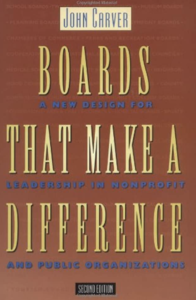
After joining the board of The Discovery Museum, I was gifted this book to help highlight how to make an amazing board work. This book had some really good insights. It was long in parts, but then you’d get a really insightful nugget. I really enjoy thinking about ends, instead of means. In addition learning the dynamic relationship between the board and the CEO was really interesting to me.
- When on a board, do not regurgitate or do staff work. You need strong boards that are not too weak to accomplish anything or too strong they manage the organization.
- Boards should be proactive. The essence of any organization lies in what it believes, what it stands for, and what and how it values. Boards should facilitate this.
- Boards should focus on policy – values and perspectives. Boards should focus on the forest, not the trees and tackle the large policies, and leave the smaller ones to the CEO and staff. Policies should be simple, clear, and written down.
- The elements of the board. “Policymaking is not all of a board’s job; linkage with the external environment, assessment of executive performance, and … fundraising must be mastered.”
- The most important work of any governing board is to create and re-create the reason for organizational existence.
- Leadership should view the world in a slightly wider lens. Focus more on results, but do not instruct how to get there.
- Do not confuse the means with the ends. “People tend to become so engrossed in activity that they lose sight of its purpose.” Why are we doing this? Is it working? e.g. boards may focus on morale (means), but don’t review results (ends)… have an inverted perspective.
- AI is predicting based on existing info. Creativity is connecting the unconnected and generating something that was unpredictable.
- The relationship between a board and a CEO should be good. The board has one employee, the CEO. The CEO has the rest of them. The CEO insulates the staff from the board. The board focuses on the CEO’s achievement of end policies. The CEO’s work is a means to this end.
- The CEO must influence culture for the organization’s impact on the world to meet board expectations. The CEO must also set a high level of ethics, prudence, creativity for the development of people. The CEO should expect the board to be clear about the rules and play by them.
- A board shall deliberate in many voices but govern in one.
- Board size – the simple rule is to justify over 7. Larger boards are easier to manipulate, less individual responsibilities and scheduling issues. Officers can include – president (integrity of board process). VP (Acts in absence of president), Secretary (legitimacy of board docs)
- It is better to obtain a good leader who can invest three hours a month than a marginal one who has thirty hours to give.
- Like the parent of a two-year old, the governing board knows it has the power, but never feels truly in charge.
- A jumbo jet cannot be flown using the cockpit technology of a crop duster.
- As a board, be obsessed with ends. Then the board can tackle difficult questions by mobilizing board time, mechanics, and concern with what is to be done at what cost.
- Emphasizing the avoidance of errors rather than the creation of breakthroughs, does not build leaders but followers. Demand daring. Have risk tolerance. Bring bigness into the board room when making decisions. Do not tolerate smallness.
- The board should do well to tolerate a few more empty seats instead of rushing to fill them.
- Five qualifications of leadership at a board level: 1. Commitment to the mission. 2. Think in terms of systems and context. 3. Eagerness to deal with values, vision, and long-term. 4. Ability to participate assertively in deliberation. 5. Willingness to delegate.
- Knowledge is an investment.
- When leaders are learning and growing, everything about them communicates the same opportunity to others…. They’re excited. They can do things differently… They can see their leaders grow.
